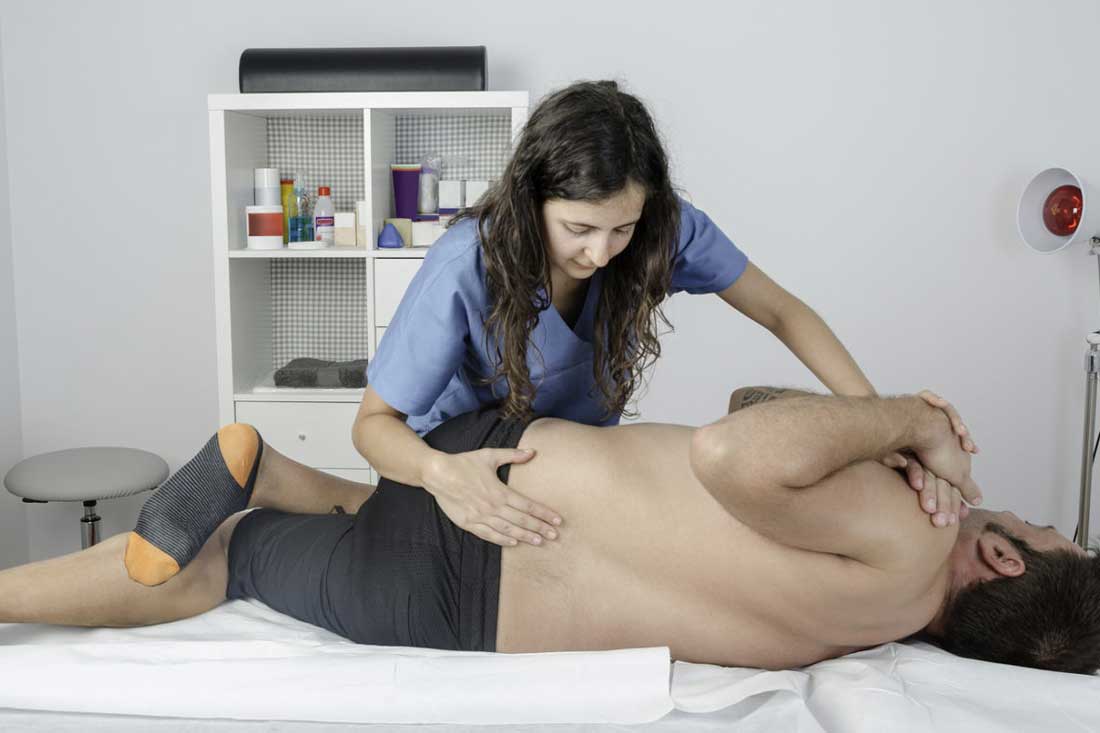Sometimes when you stand up from your chair, you might feel a slight ache in your lower back, and this symptom might be the SI joint of yours acting up. Now keep in mind that you mustn’t allow it to get the best of you. Just take charge of the situation by following a good treatment plan which cures as well as brings the necessary pain relief.
Defining SI Joint
The full name of SI joint is sacroiliac joint and there are basically two of them present in the lower back of the human body. They sit on each part of your spine and their major job is for carrying the upper body weight as and when you walk or stand and when you are shifting the load of your legs.
Keep in mind that the SIJ (Sacroiliac Joints) are the most critical linkage system among your pelvis and spine. There is the major tailbone (which is called sacrum) that connects the left and right sides of then ilia (pelvic bone) so that the sacroiliac joints are formed. It is necessary that the sacroiliac joints must be quite stiff or rigid among the pelvic bones. It must allow a few degrees of movement.
For some people, due to extra mobility or trauma, the sacroiliac joints will have a lot of uncontrolled motion. So, what happens is that it will allow the sacroiliac joints to get used to the stressed or abnormal joint position and thereby resulting in the SIJ pain. If your sacroiliac joints aren’t moving most of the time because of the excessive movement or stiffness, it is called as Sacroiliac Joint Dysfunction, and this will result in sacroiliac pain. It is necessary for you to have both the muscle control and SIJ movement around this area for avoiding any kind of SIJ injury and pain. Some of the most commonly sacroiliac dysfunctions will lead to hip, lower back, sciatic and buttock pain.
How Does SIJ Pain Feel Like?
If you are suffering from SI pain, then you would feel a sharp or dull kind of ache. First it would start from your SI joint however, it will move towards your thighs, buttocks and upper back as well as groin. At times while standing up, the pain may get triggered and most of the time, you might feel it being one sided especially on your lower back. In addition, you may see that the pain bothers you a lot in the morning while it gets better as the day passes. Frankly, it is more common than you think. Simply on an average 20%-25% of the people who suffer from bruises like these will have issues with their SI joint.
How This Happens
The pain occurs as and when the SI joint is inflamed. To be frank, there are many reasons why this might happen. Sometimes you might get hurt while playing sports or when you fall. There are chances you might get this problem from doing regular activities like jogging.
Are you taking uneven strides while walking as your one leg is longer than the other? This could be due to SI joint pain. At times, you might feel pain when the ligament which holds your SI joint together gets damaged which might lead to the joint moving abnormally. Sometimes arthritis might lead to this issue, especially the one that affects your spine which is called as ankylosing spondylitis and this can severely damage your SI joint. There is also a chance that you might get hurt when the cartilage present in the SI joint gets slowly worn off as you age.
You might suffer from the pangs of SI joint pain when you are pregnant. Here in this case, your body release hormones which might cause the joints to loosen up and move a lot and this will change the way on how the joint moves.
Causes of Sacroiliac Joint Pain
There are many reasons on how a person might get sacroiliac joint pain. But the most common ones are the below –
- Hypomobility or Stiffness
- Hypermobility or Instability
Here the hypomobility is simply associated with pathologies which stiffens the sacroiliac joints like the Ankylosing Spondylitis.
Causes of Sacroiliac Joint Hyper mobility
It is important that the sacroiliac joints should move a certain degree for making a normal movement. Like most of the joints, here the surrounding muscles of yours will assist in stabilizing the sacroiliac joints while being stressed or when you are in vulnerable positions. The most significant sacroiliac stabilizing muscles are present in the deep abdominal core muscles and in your deep gluteal muscle groups.
The core muscles of yours, which are the transverses abdominis and oblique abdominals which are attached to the iliac bones assist in closing the pelvis and even improves the control, position and the stability of the sacroiliac joints.
Various researchers have found out the contractions of the transversus abdominis muscles will easily get stiff and even support the sacroiliac joints. This is an improvement which is bigger than what is caused by the abdominal bracing action where all the lateral abdominal muscles are used. In addition, even researchers were able to find out that the deep buttock (gluteal) muscles are very much necessary for controlling the rear and lateral aspects of the hip and pelvis. Now as these muscles groups get weak or they end up getting lack of endurance especially on the sacroiliac joints, then it becomes vulnerable to excessive movements. This can lead to SIJ hypermobility dysfunction or even the instability and lead to subsequent sacroiliac joint pain.
Symptoms of Sacroiliac Joint Dysfunction
You might it surprised to know that the sacroiliac joint dysfunction can lead to various kinds of hip and back injuries. It can even lead to lower back, buttock, groin, hip and sciatic pain. Sometimes, the pain can get worse when one walks and stands and will always improve if lying down.
For certain people, the sacroiliac joint pain can be quite severe when sitting cross legged and is even more painful when lying on the side for a long period of time. Stair climbing, bending forward, rising from seated position and hill climbing can also lead to sacroiliac pain. There are studies which show that sacroiliac pain increases while having sex and during menstruation in women.
Diagnosing Sacroiliac Joint Pain
If accurately done, diagnosing sacroiliac dysfunction and joint pain is easy but often it is difficult as the symptoms can mimic other common back conditions. Mechanical low back pain conditions like facet joint syndrome or a bulging disc are some of the common ones. If you are planning of taking an X-ray, it is of less diagnostic benefit. MRI may show signs of sacroiliac joint inflammation or eliminate other potential pathologies.
Sometimes you might take a physical examination by your experienced musculoskeletal physiotherapist and surely it is the one of the apt methods for assessing the sacroiliac joint pain or instability.
Treating Sacroiliac Joint Pain
Treatment 1 – SIJ Joint Protection and Pain Relief
Keep in mind that the major reason you seek treatment for sacroiliac joint dysfunction is managing your sacroiliac pain. Frankly, it is the final symptom developed and should be the first symptom to improve that you need to follow.
The treatment even involves managing your inflammation. Do you know that the sacroiliac joint inflammation it best eased through techniques and ice therapy or exercises that off load the inflamed structures? Sometimes there might be a chance that your doctor recommends a course of non-steroidal anti-inflammatory drugs such as ibuprofen.
No doubt, your physiotherapist will use various kinds of treatment tools to lower your sacroiliac pain and inflammation. These treatments consist of electrotherapy, ice, acupuncture, offloading taping techniques, a SIJ belt, soft tissue massage and temporary use of a mobility aid (e.g. cane or crutch) to off-load the affected side.
Treatment 2 – Restoring the Normal Strength & ROM
As and when your inflammation and pain settles, your physiotherapist will turn the attention to restoring your normal pelvic alignment and sacroiliac joint range of motion, muscle length and resting tension, muscle strength and endurance, proprioception, balance and gait (walking pattern).
Initially, your physiotherapist will start with your lower abdominal and hip core stability program to facilitate your important muscles that dynamically control and stabilize your sacroiliac joints.
Various researchers have found out the significance of your hip muscle recruitment patters in terms of the normal order like deep followed by intermediate and lastly the superficial muscles firing patter which is in the normal pain-free hips. During this treatment, your physiotherapist will find out the recruitment pattern of your muscles and will provide the required exercises which are specific and necessary for your needs. It is necessary that you always consult your physio before trying out any exercise.
Treatment 3 – Bring Back the Full Function
As your sacroiliac joint dynamic control gets better, your physiotherapist will then turn the attention to restoring your normal pelvic alignment and sacroiliac joint range of motion during more stressful positions and postures along with working on your muscle power, proprioception, balance and gait (walking pattern).
Based on the chosen sport or activities of daily living, your physiotherapist will aim to restore your SIJ function to safely allow you to return to your desired activities. Keep in mind that everyone has different demands for their sacroiliac joints that will determine what specific treatment goals you need to achieve. For some it will be simply to walk around the block. Others may wish to run a marathon.
Your physiotherapist will tailor your sacroiliac joint rehabilitation to help you achieve your own functional goals.
Treatment 4 – Avoiding Unnecessary Recurrence
There is less chance for the sacroiliac joint dysfunction to return. Now the main reason for this is that it might happen or occur again because of insufficient rehabilitation. Particularly, there might be chance of poor compliance with deep abdominal and hip core muscle exercises. It is necessary that one must continue a version of such warms up routinely a few times per week.
Your physiotherapist will assist you in identifying the best exercises for you to continue indefinitely.
In addition to your muscle control, your physiotherapist will assess you SIJ, spine, hip and lower limb bio mechanics and correct any defects.
It may be as simple as providing you with adjacent muscle exercises or some foot orthotics to address any bio mechanical faults in the legs or feet.
Fine tuning and maintenance of your sacroiliac joint stability and function is best achieved by addressing any deficits and learning self-management techniques. Your physiotherapist will guide you.




